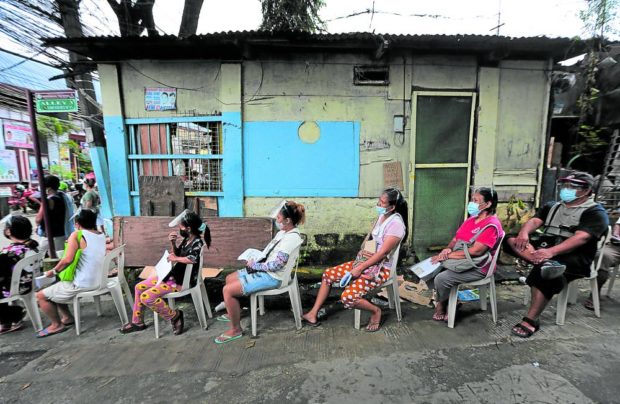
WAITING FOR AID In this photo taken in August, residents of Payatas village in Quezon City queue to receive cash aid from the government. —GRIG C. MONTEGRANDE
MANILA, Philippines — Around 22,000 households in typhoon-vulnerable municipalities in Catanduanes and Northern Samar can benefit from the financial assistance agreement between the Department of Social Welfare and Development (DSWD) and the United Nations Children’s Fund (UNICEF).
The DSWD said in a statement on Monday that around 22,000 Pantawid Pamilyang Pilipino Program beneficiaries in four municipalities in Catanduanes and five municipalities in Northern Samar shall receive financial assistance three days before the predicted landfall of a Category 4 typhoon under the United Nations Central Emergency Response Fund for Anticipatory Action for predictable hazards (CERF AA).
The agreement was signed on June 14.
Each family will receive P1,000 through the Land Bank of the Philippines. The amount is calculated as 30 percent of children’s estimated minimum expenditure basket for nutrition, education, water, sanitation and hygiene, and child protection services, DSWD said.
The municipalities covered in Catanduanes are Baras, Bato, San Andres, and Virac.
Also included are Catarman, Catubig, Gamay, Mondragon, and San Roque in Northern Samar.
Aside from the cash assistance, UNICEF is also piloting anticipatory multi-purpose cash transfers that will utilize the existing national government’s social protection systems to mitigate the impact of disasters.
“This is the first time that we will test the concept of anticipatory action through a shock-responsive social protection model. Through this intervention, the most at-risk communities will have better financial resources to bounce back after a typhoon,” UNICEF Philippines Deputy Representative Behzad Noubary explained.
“Traditional disaster response, when complemented with anticipatory actions, can significantly reduce the impact of disasters and allow for a faster recovery,” he added. — Xander Dave Ceballos, trainee
RELATED STORY:
Incoming DSWD chief Tulfo eyes distributing cash aid in lump sum
DILG: Around 4 million Typhoon Odette victims so far get P4.15-B cash aid